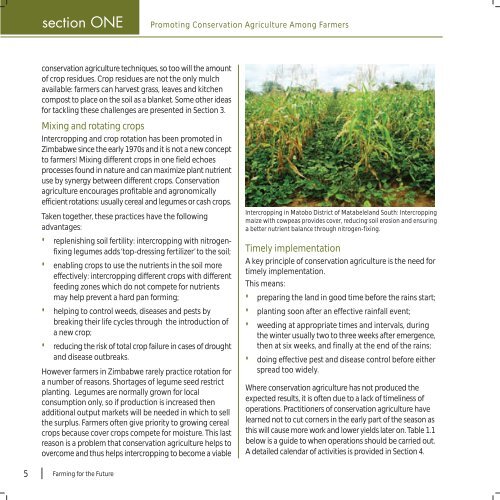A Guide to Conservation Agriculture in Zimbabwe - Canadian ...
A Guide to Conservation Agriculture in Zimbabwe - Canadian ...
A Guide to Conservation Agriculture in Zimbabwe - Canadian ...
Create successful ePaper yourself
Turn your PDF publications into a flip-book with our unique Google optimized e-Paper software.
section ONE<br />
Promot<strong>in</strong>g <strong>Conservation</strong> <strong>Agriculture</strong> Among Farmers<br />
conservation agriculture techniques, so <strong>to</strong>o will the amount<br />
of crop residues. Crop residues are not the only mulch<br />
available: farmers can harvest grass, leaves and kitchen<br />
compost <strong>to</strong> place on the soil as a blanket. Some other ideas<br />
for tackl<strong>in</strong>g these challenges are presented <strong>in</strong> Section 3.<br />
Mix<strong>in</strong>g and rotat<strong>in</strong>g crops<br />
Intercropp<strong>in</strong>g and crop rotation has been promoted <strong>in</strong><br />
<strong>Zimbabwe</strong> s<strong>in</strong>ce the early 1970s and it is not a new concept<br />
<strong>to</strong> farmers! Mix<strong>in</strong>g different crops <strong>in</strong> one field echoes<br />
processes found <strong>in</strong> nature and can maximize plant nutrient<br />
use by synergy between different crops. <strong>Conservation</strong><br />
agriculture encourages profitable and agronomically<br />
efficient rotations: usually cereal and legumes or cash crops.<br />
Taken <strong>to</strong>gether, these practices have the follow<strong>in</strong>g<br />
advantages:<br />
• replenish<strong>in</strong>g soil fertility: <strong>in</strong>tercropp<strong>in</strong>g with nitrogenfix<strong>in</strong>g<br />
legumes adds ‘<strong>to</strong>p-dress<strong>in</strong>g fertilizer’ <strong>to</strong> the soil;<br />
• enabl<strong>in</strong>g crops <strong>to</strong> use the nutrients <strong>in</strong> the soil more<br />
effectively: <strong>in</strong>tercropp<strong>in</strong>g different crops with different<br />
feed<strong>in</strong>g zones which do not compete for nutrients<br />
may help prevent a hard pan form<strong>in</strong>g;<br />
• help<strong>in</strong>g <strong>to</strong> control weeds, diseases and pests by<br />
break<strong>in</strong>g their life cycles through the <strong>in</strong>troduction of<br />
a new crop;<br />
• reduc<strong>in</strong>g the risk of <strong>to</strong>tal crop failure <strong>in</strong> cases of drought<br />
and disease outbreaks.<br />
However farmers <strong>in</strong> <strong>Zimbabwe</strong> rarely practice rotation for<br />
a number of reasons. Shortages of legume seed restrict<br />
plant<strong>in</strong>g. Legumes are normally grown for local<br />
consumption only, so if production is <strong>in</strong>creased then<br />
additional output markets will be needed <strong>in</strong> which <strong>to</strong> sell<br />
the surplus. Farmers often give priority <strong>to</strong> grow<strong>in</strong>g cereal<br />
crops because cover crops compete for moisture. This last<br />
reason is a problem that conservation agriculture helps <strong>to</strong><br />
overcome and thus helps <strong>in</strong>tercropp<strong>in</strong>g <strong>to</strong> become a viable<br />
Intercropp<strong>in</strong>g <strong>in</strong> Ma<strong>to</strong>bo District of Matabeleland South: Intercropp<strong>in</strong>g<br />
maize with cowpeas provides cover, reduc<strong>in</strong>g soil erosion and ensur<strong>in</strong>g<br />
a better nutrient balance through nitrogen-fix<strong>in</strong>g.<br />
Timely implementation<br />
A key pr<strong>in</strong>ciple of conservation agriculture is the need for<br />
timely implementation.<br />
This means:<br />
• prepar<strong>in</strong>g the land <strong>in</strong> good time before the ra<strong>in</strong>s start;<br />
• plant<strong>in</strong>g soon after an effective ra<strong>in</strong>fall event;<br />
• weed<strong>in</strong>g at appropriate times and <strong>in</strong>tervals, dur<strong>in</strong>g<br />
the w<strong>in</strong>ter usually two <strong>to</strong> three weeks after emergence,<br />
then at six weeks, and f<strong>in</strong>ally at the end of the ra<strong>in</strong>s;<br />
• do<strong>in</strong>g effective pest and disease control before either<br />
spread <strong>to</strong>o widely.<br />
Where conservation agriculture has not produced the<br />
expected results, it is often due <strong>to</strong> a lack of timel<strong>in</strong>ess of<br />
operations. Practitioners of conservation agriculture have<br />
learned not <strong>to</strong> cut corners <strong>in</strong> the early part of the season as<br />
this will cause more work and lower yields later on. Table 1.1<br />
below is a guide <strong>to</strong> when operations should be carried out.<br />
A detailed calendar of activities is provided <strong>in</strong> Section 4.<br />
5 Farm<strong>in</strong>g for the Future
















